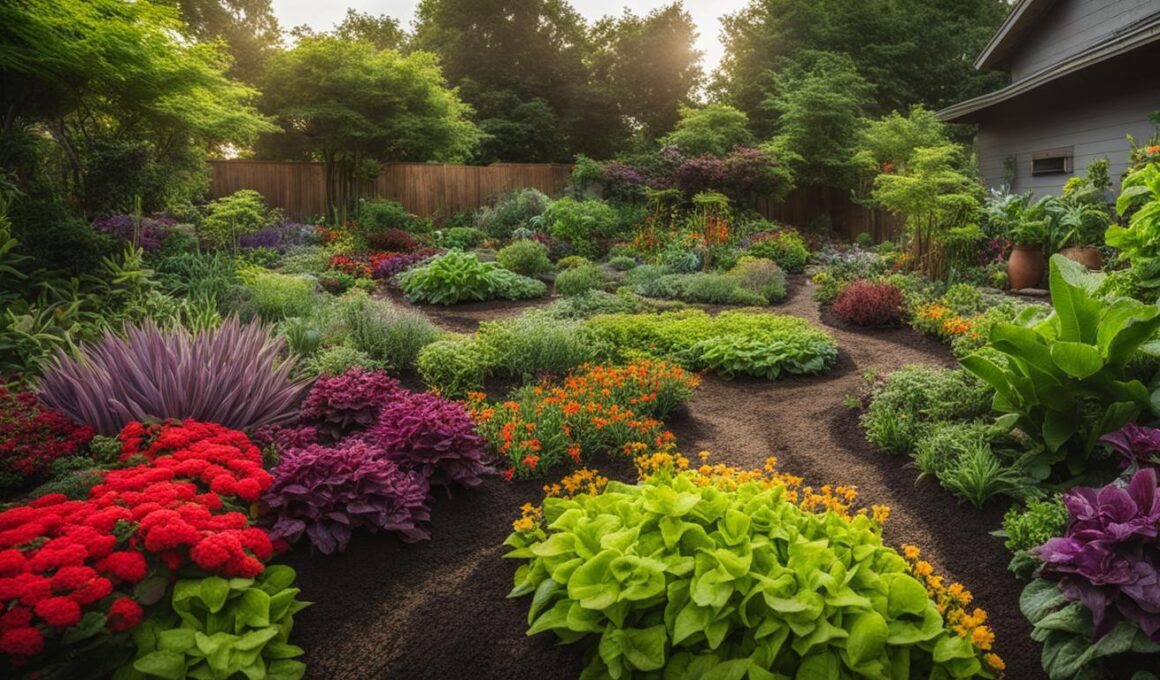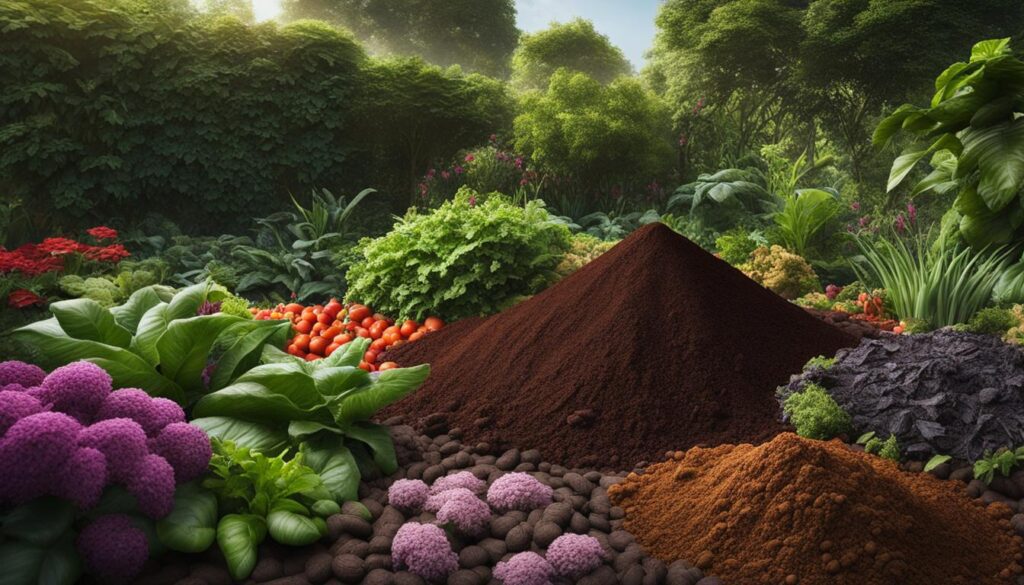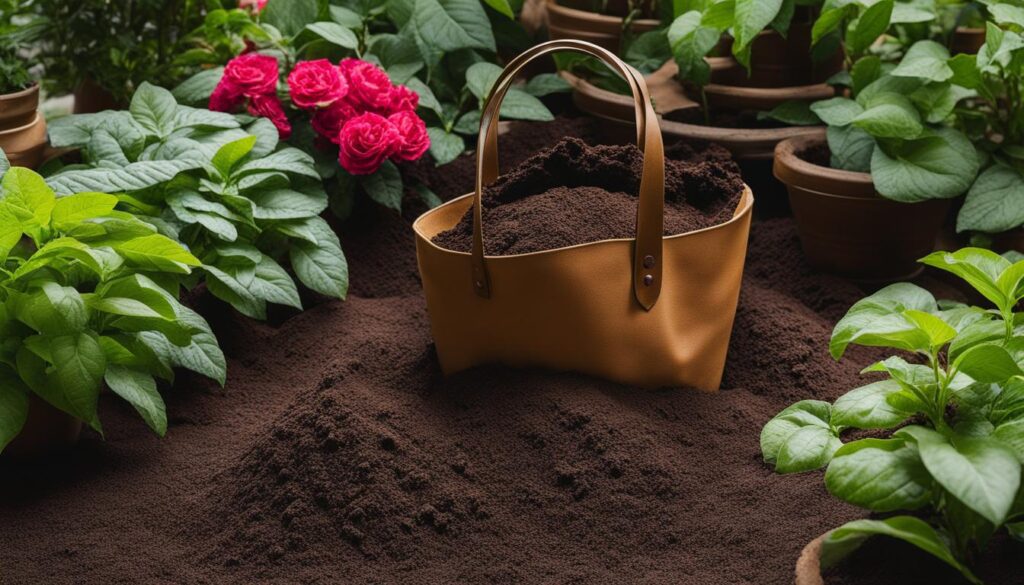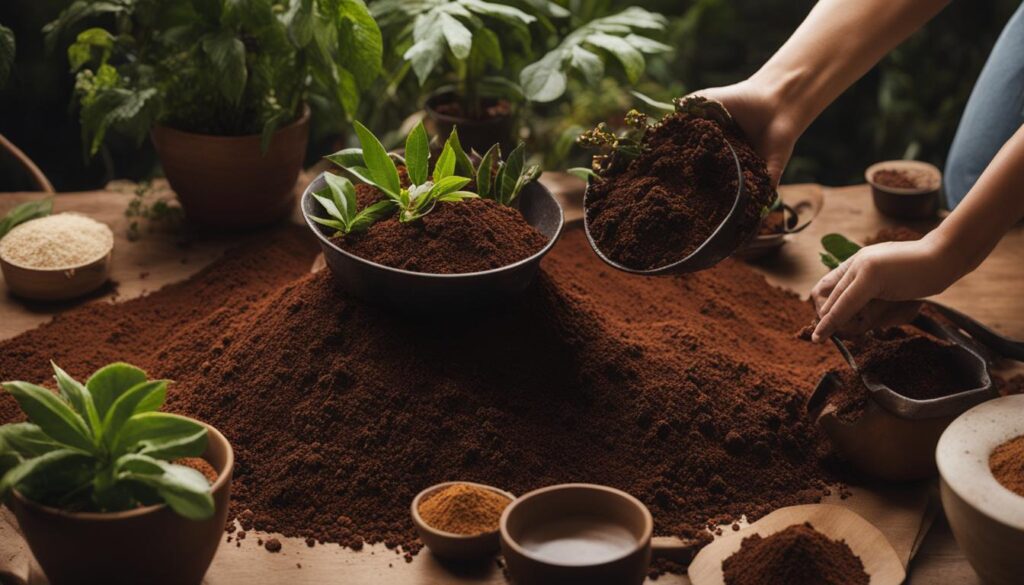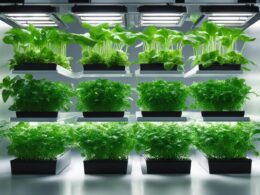If you’re an avid gardener seeking to boost the growth and health of your plants, you may have heard about the benefits of using coffee grounds in your garden. As an organic source of essential nutrients like nitrogen, potassium, and phosphorus, coffee grounds offer a sustainable and budget-friendly option for nurturing your plant life. However, it’s vital to know which plants thrive with the addition of coffee grounds, as not all species benefit equally from them.
In this article, we’ll explore the benefits of coffee grounds in gardening, including which plants benefit the most from their use. We’ll also cover some expert tips on incorporating coffee grounds into your garden and address common misconceptions about their use. By understanding the best practices for using coffee grounds, you can make the most of this organic soil amendment and contribute to a greener and healthier world.
Key Takeaways
- Coffee grounds contain essential nutrients like nitrogen, potassium, and phosphorus that can benefit certain plants in your garden.
- Plants that thrive with coffee grounds include carrots, eggplants, radishes, blueberries, strawberries, citrus trees, African violets, and jade plants.
- Using coffee grounds can improve soil structure, promote microbial activity, and enhance water retention.
- Composting coffee grounds or mixing them with other organic matter is the best practice for incorporating them into your garden.
- Understanding the proper methods and debunking misconceptions about coffee grounds allows gardeners to make the best use of them in nurturing their greens effectively.
Unlocking the Secrets of Coffee Grounds in Gardening
The use of coffee grounds in gardening has seen a surge of interest on social media platforms such as TikTok and Instagram, where users share their experiences and advice on unlocking the secrets of using coffee grounds for their plants. Here, we dive into some of the incredible benefits of coffee grounds, while also highlighting some crucial considerations to keep in mind when adding them to your garden.
Enhancing Soil Structure
One of the most notable advantages of coffee grounds as a soil amendment is their ability to improve soil structure. When used correctly, coffee grounds can play a significant role in breaking up dense soil and improving aeration, thus promoting healthy root growth and assisting plants in better absorbing water and nutrients. Plus, their organic nature serves as a natural source of nourishment for beneficial microorganisms, which in turn help build a more fertile soil environment.
Boosting Microbial Activity and Water Retention
Composted coffee grounds serve as an abundant food source for the microbes in your garden. These tiny organisms decompose the coffee grounds, transforming them into plant-available nutrients and enriching the soil. In addition, coffee grounds have excellent water retention properties. This means they can absorb water and release it slowly, ensuring your plants have access to moisture over an extended period while reducing the need for frequent watering.
However, there are some essential precautions to take when utilizing coffee grounds in your garden:
- Use coffee grounds in moderation. Over-application of coffee grounds may cause soil compaction, leading to restricted root growth and reduced water infiltration.
- Compost coffee grounds before use. Fresh coffee grounds may be too acidic for some plants and can temporarily affect soil pH levels. Composting allows coffee grounds to be safely integrated into your garden without harming your plants.
In conclusion, when used responsibly, coffee grounds can serve as an excellent addition to your garden, enhancing soil structure and boosting microbial activity. To unlock the full potential of coffee grounds, it is crucial to properly compost and incorporate them into your garden for the best results.
Benefits of Using Coffee Grounds for Your Plants
The Nitrogen Boost
One of the primary advantages of using nitrogen-rich coffee grounds in your garden is the significant boost in nitrogen they provide, which is essential for healthy plant growth. Although they are not a standalone fertilizer, the grounds release nitrogen in a more absorbable form for plants once broken down by soil microbes. By composting them or mixing them with other nitrogen sources, you can create an effective, slow-release fertilizer that benefits your plants.
Inviting Beneficial Worms to Your Garden
Worms play a vital role in gardening, and coffee grounds are an excellent addition to their diet. In fact, coffee grounds for worms often lead to higher-quality worm castings in vermicomposting bins, which enriches your soil with essential nutrients. Attracting benevolent worms and microorganisms to your garden fosters a healthier and more fertile environment for your plants to thrive.
Improving Soil Structure and Water Retention
Coffee grounds contribute positively to your garden’s soil structure, enhancing its ability to retain moisture—an essential factor in water retention gardening. This is particularly important for maintaining moist soil conditions and reducing the frequency of watering. Furthermore, organic matter from the breakdown of coffee grounds can elevate drainage and aeration, promoting healthier plant roots and overall growth.
- Nitrogen-rich coffee grounds provide a valuable nitrogen source for plants.
- Grounds attract beneficial worms and microorganisms, increasing soil fertility.
- Improves soil structure and water retention for moist, well-draining conditions.
Aside from the nitrogen boost, inviting beneficial worms, and improving soil structure and water retention, coffee grounds can serve as an excellent organic soil amendment when used appropriately. It is worth employing these grounds in your garden for a sustainable, eco-friendly approach to horticulture.
The Best Plants to Enrich with Coffee Grounds
When gardening with coffee grounds, it’s essential to be aware of the best plants for coffee grounds application. Coffee grounds are particularly well-suited for acid-loving and nutrient-hungry plants due to their slightly acidic profile and rich nutrient content. Here’s a list of plants that have been known to reap the most coffee grounds plant benefits:
- Carrots
- Eggplants
- Radishes
- Blueberries
- Strawberries
- Avocado Trees
- African Violets
- Jade Plants
- Azaleas
- Camellias
- Gardenias
Each of these plants has varying reasons for its compatibility with coffee grounds. For instance, blueberries and azaleas are acid-loving plants, while carrots and radishes appreciate the nitrogen and phosphorus available in the grounds. African violets, on the other hand, benefit from the improved soil structure and water retention.
It’s important to note that coffee grounds are not suitable for every plant, especially those preferring alkaline soil conditions or dry conditions like succulents and cacti. To provide even more guidance on which plants respond well to coffee grounds, here’s a table highlighting the coffee grounds plant benefits for some specific plants:
| Plant | Reason for Compatibility |
|---|---|
| Carrots | Appreciate the nitrogen and phosphorus content in the grounds |
| Blueberries | Acid-loving and appreciate the nutrients provided by coffee grounds |
| African Violets | Thrive with improved soil structure and water retention |
| Jade Plants | Benefit from the additional nutrients present in coffee grounds |
Remember to always be cautious and moderate when applying coffee grounds to plants. Even for those considered the best-suited, excessive amounts or improper use of grounds can lead to detrimental effects on plant growth and health.
Expert Tips on Incorporating Coffee Grounds into Your Garden
As a sustainable and eco-friendly option for gardening, coffee grounds can enrich your garden with essential nutrients when incorporated correctly. Composting coffee grounds should ideally be mixed with other organic matter to make the most out of their benefits. Here are some gardening tips coffee grounds enthusiasts can follow:
Mixing Coffee Grounds with Other Organic Matter
For optimal results, mix coffee grounds with other organic matter in a compost pile, making sure that grounds account for no more than 20-35% of the pile’s volume. This practice prevents excessive acidity and compaction, thereby promoting proper compost balance and ultimately enriching the soil with a variety of nutrients.
To mix coffee grounds effectively with other organic materials, follow these coffee grounds composting tips:
- Choose complementary organic materials: Combine your coffee grounds with materials such as grass clippings, fruit and vegetable scraps, leaves, and other green or brown organic matter.
- Layer the compost: Build layers of coffee grounds, organic materials, and soil in your compost pile, ensuring even distribution of moisture and air circulation.
- Monitor the compost pile: Keep an eye on your compost pile’s temperature, moisture content, and smell to ensure its proper decomposition and prevent the growth of harmful bacteria or pests.
- Turn the pile regularly: Regularly turning your compost pile helps to speed up the decomposition process and evenly distribute heat and air.
Remember to use coffee grounds in moderation to avoid too much acidity and compaction in your garden. Applying these gardening tips coffee grounds enthusiasts can follow will help you take full advantage of this sustainable and eco-friendly gardening solution.
Addressing Common Misconceptions About Coffee Grounds in Gardening
As coffee grounds gain popularity in gardening practices, it’s crucial to address common coffee grounds misconceptions and coffee grounds garden myths. With a more accurate understanding of coffee grounds in gardening, you’ll be better equipped to use them effectively in your garden.
Myth 1: Coffee grounds consistently alter soil pH: While some believe used coffee grounds are a reliable soil acidifier, in reality, their acidity can vary. Depending on factors like the type of coffee bean and the brewing method, they might not significantly change soil pH. To ensure your plants receive the right pH levels, test both the coffee grounds and your soil, making necessary adjustments based on the results.
Myth 2: Coffee grounds are caffeine-free: Although brewing removes most of the caffeine from coffee grounds, some traces may linger. This can hinder the growth of certain plants, such as tomatoes, and may inhibit seedling germination. Therefore, it’s essential to be cautious when applying coffee grounds around plants sensitive to caffeine.
Myth 3: More coffee grounds are always better: Over-applying coffee grounds in the garden can negatively affect soil hydrophobicity and lead to nutrient overload. Over time, this can cause various issues such as soil compaction or increased risk of pest infestations. To avoid these issues, apply coffee grounds in moderation and mix them with other organic matter, such as compost.
| Myth | Truth |
|---|---|
| Coffee grounds consistently alter soil pH | Acidity of coffee grounds varies; testing recommended |
| Coffee grounds are caffeine-free | Some caffeine remains; sensitive plants may be affected |
| More coffee grounds are always better | Moderation and mixing with other organic matter is key |
By addressing these misconceptions and understanding the nuances of using coffee grounds in gardening, you can make more informed decisions and foster a thriving garden environment. Remember to always research your plant’s specific needs and consider coffee grounds as just one component of a larger, balanced garden-care regimen.
What Plants Can Benefit from Using Coffee Grounds as Fertilizer?
Many plants thrive when using coffee grounds fertilizer. Acid-loving plants like azaleas, rhododendrons, and blueberries benefit from the acidic nature of coffee grounds. Additionally, coffee grounds help enrich the soil with essential nutrients such as nitrogen, potassium, magnesium, and phosphorus, making them suitable for vegetables and flowering plants.
Conclusion
In summary, coffee grounds can be a valuable asset for gardeners when used with knowledge and moderation. The multiple benefits of coffee grounds include boosting nitrogen levels, attracting beneficial worms, and improving soil structure. When selectively applied, certain plants thrive with coffee grounds, making them a sustainable and organic addition to their care regimen.
It is essential to understand the proper methods, such as composting and balanced mixing, to make the best use of coffee grounds for nurturing your plants effectively. By debunking some common misconceptions, you can avoid any detrimental effects on your plants and soil.
Remember to choose plant species that are suitable for coffee ground application, such as carrots, eggplants, radishes, blueberries, strawberries, avocado trees, African violets, jade plants, azaleas, camellias, and gardenias. Keep in mind that coffee grounds are not a one-size-fits-all solution for all plants, and it is crucial to use them wisely in conjunction with other organic materials to make the most of their potential benefits.





